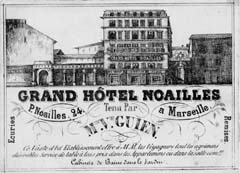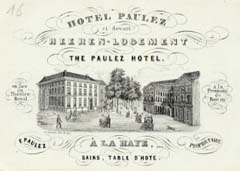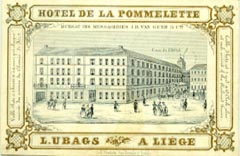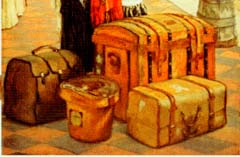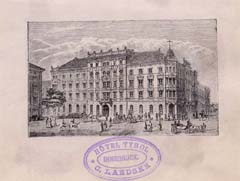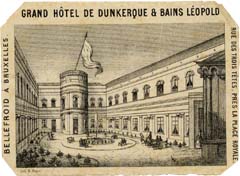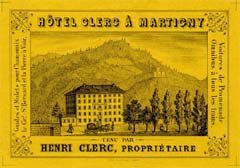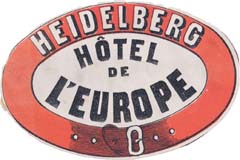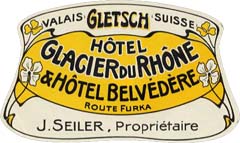A short history
of hotel luggage labels- 1
Origins and the early types (1850-1900)
by Joao-Manuel
Mimoso
|
|
| Beginning an essay on
a subject of indeterminate origin is a tricky business. I will, quite
arbitrarily, begin this tale in 1851 -year of the Crystal Palace Exhibition
which, to some authors, marks the origin of tourism as we know it.
By this time hotel owners were in the habit of ordering a copper plate
engraving with an image of their establishment which was then used
to illustrate a number of paper items (such as trade-cards, bills
and letters) that were needed for the running of their business. The
card at right, for a French hotel in Marseilles, dates from about
this time. |
|
|
| Somewhat surprisingly,
the most creative and graphically appealing hotel trade-cards of the
time did not come
from old bastions of European tourism like France, Italy or Switzerland,
nor from the United States where the concept of the Grand Hotel may
arguably be said to have its roots, but from Belgium. Around 1839
a new technology had been developed in Brussels by which it was possible
to produce prints of a very high quality on a treated stock that,
after hand polishing, had a china-like gloss whence its French name
"cartes porcelaine" ("china-cards"). |
|
|
| This type of card became
the rage of the day in this part of Europe and soon every business
owner was ordering his own trade-card, often printed in black but
at times also using gold, rose, green or blue. The geographic area
of production of these "china-cards" spread to include the
whole of Belgium, Holland, NW Germany and several print-shops in England.
Unfortunately the white polishable compound was lead based and, in
time, it was recognized that it poisoned the laborers. After 1865
the "china-card" had all but disappeared from its country
of origin. |
|
|
| At the time of their demise,
the "china-card" had left this part of Europe with a tradition
of hotel publicity ephemera that often exhibited (as does the example
at right) all the characteristics that luggage labels would one day
have: a view of the hotel building encircled by a colored frame bearing
the name of the establishment, that of its owner and the address.
The Belgians did not invent the trade card, which is actually much
older than Belgium itself, but they experimented in new graphic solutions
and had a definite role in the establishment of what would be the
XIX century hotel luggage label graphic standards. |
|
|
| Now, we all know that
people like to keep souvenirs of their travels. At the second half
of the XIX century travel was not for the masses, as it would be a
century later, and the lucky few would like to show to the world a
mark of places visited and difficulties overcome. Just like the backpackers
of today who emblazon their knapsacks with badges of places visited,
so must the travelers of old have decorated their luggage with local
mementos including the names or images of the hotels where they stayed.
Actually the suggestion was already there because luggage dispatched
by ship or train would be labeled with the name of the port or station
for where it was bound (as can be seen in several of Tissot's travel
related paintings) and he who had a well labeled trunk was a man of
means and, possibly, of adventure. |
|
|
| When was printed the first
hotel luggage label? No one knows and possibly no one ever will! A
study of old travel scrapbooks shows that in the 1880s people used
to make passable hotel labels out of cut letterheads and other printed
paper items that included the image (or then just the name) of the
hotel. Some of these make-believe labels are not distinguishable from
authentic labels of the time and one can actually argue that they
must indeed be considered true labels since that was the intention
of the post-processing to which they were subjected. Very often this
cutting and adapting of other printed ephemera was likely done by
the hotel personnel, so as to be able to satisfy the requests of patrons
who wanted pasteable souvenirs of the establishment. The example at
right was made by stamping the name of the hotel on a plain print
of the building made for a different purpose. |
|
|
| The oldest true label
in my collection is for the Grand Hotel de Dunkerque in Brussels and
can be dated to the period from 1873 (when the hotel reopened in the
buildings of the Leopold Baths) to 1877 (date after which, neither
the hotel, nor its owner are mentioned in Belgian almanacs). The image
of the hotel building is similar to the images found in the Belgian
"china-cards" of a few years before (down to the characteristic
miniaturization of people and vehicles) but it is printed on a very
light stock and the corners have been cut off to avoid the ripping
of the label when the luggage rubbed against other objects. I acquired
this label for the equivalent to $1 in a bookshop in Lisbon, where
it was found folded in half amidst a bunch of old travel papers, and
am thus sure that it has not been meddled with in modern times. It
must be one of the very earliest examples of luggage labels and given
the history of "china-cards" it is only fitting that this
was printed for a hotel in Brussels. |
|
|
| The earliest firsthand
report on hotel luggage labels that I know of, is a reference to a
long trip in the French and Italian Rivieras, in the winter of 1885-86,
during which a traveler's luggage was labeled at the Hotel Royal in
San Remo and nowhere else. Yet, this bit of information should not
be misinterpreted: the fact that labels were not affixed at other
hotels means only that porters were not yet generally instructed to
label a guest's luggage. The conclusion that other local hotels did
not, at the time, have luggage labels is not supported by the data
available. In the 1880s hotel luggage labels were, in fact, used in
at least Austria, Germany, Switzerland, Belgium, Holland, France,
Ireland, England, Italy and Spain and both this wide range of countries
and the fact that labels had, by then, evolved graphically in a specific
way prove that they were not a very recent affair. |
|
|
| By the mid 1880s three
main graphic types had developed, all of them based in much earlier
trade-card types. The most common and representative early type of
hotel label depicted a line drawing of the building printed in black
on white or colored paper, as in the label for the Hotel Clerc, at
right above.. During the 1880s this type of label started incorporating
a lithographically printed red frame and assumed the general aspect
that (with varying colors and modernized settings) would subsist well
into the XX century. The earliest elliptical red-framed label in my
collection was printed in Germany and is reproduced at right. |
|
|
| Another recurrent type
of hotel luggage label had only lettering and eventually some geometrical
decoration and it too derives graphically from a common solution in
trade cards. By the 1880s such labels were being lithographed in two
colors and one particular type using a frame in the shape of a buckled
belt would also become a characteristic and lasting design. The "belt-labels"
were used in many products and the origin of the idea to adapt it
for hotel use is a mystery but the earliest example I know is illustrated
at right, dates from the mid 1880s and comes from Germany. |
|
|
| A third type of hotel
label that was in use by the mid 1880s (for instance by the aforementioned
Hotel Royal in San Remo) represents the hotel symbolically by a coat
of arms. Such "heraldic" labels seem to have been the last
to have come into play but can in fact trace their ancestry to the
medieval road signs that identified an inn by some graphical indication
through which an illiterate person could "read" the name
of the establishment ( the London "Swan With Two Necks",
for instance, would have a sign -and a card- showing a double headed
swan). |
|
|
|
During the 1890s the
graphics of labels evolved little but their appeal was notoriously
increased by the use of glossy finishes, a wider palette and, at
times, three and more simultaneous colors to a label, including
golden shades. By the end of the XIX century practically all hotels,
large or small, that were listed in traveler's guides could emblazon
the luggage of guests with their labels. But the winds of change
were a-blowing: a new, fresh, universal style had made its appearance
and Art Nouveau graphics would soon be seen in all kinds of paper
items, including hotel labels. Posters, on the other side, were
covering the walls of towns and soon a family tie would be established
between them and hotel labels that would radically change the appearance
of the latter and mark the onset of their Golden Age...
Read
Part 2 of this text by clicking here.
|
|
|
|
|
Lisbon, Portugal
-
first uploaded:
Nov23, 2002
-
last reviewed:
Jan 01, 2003
|
| |
|
